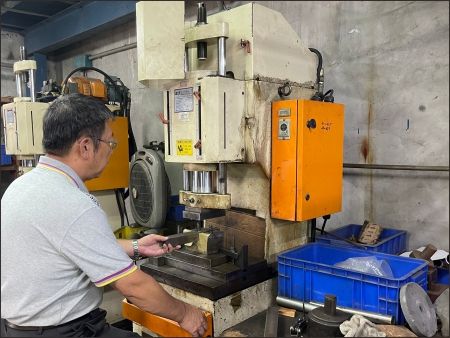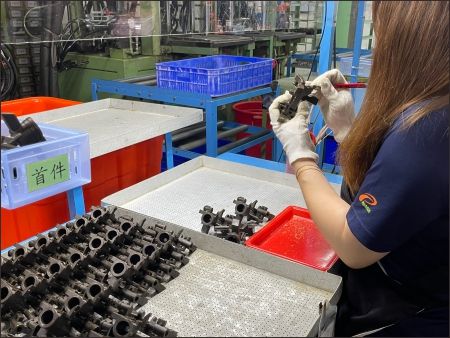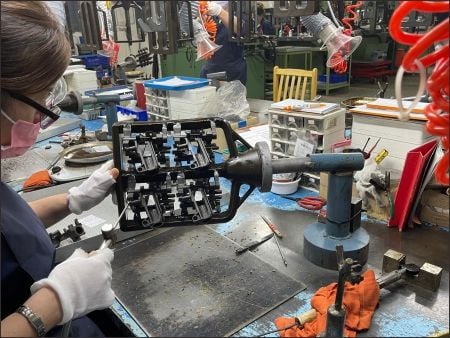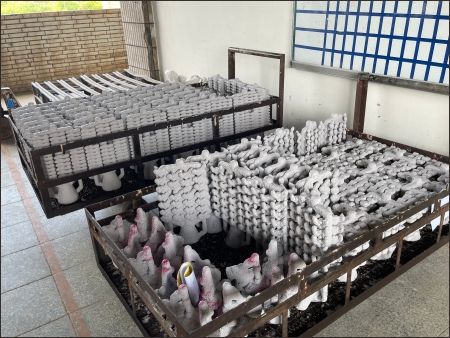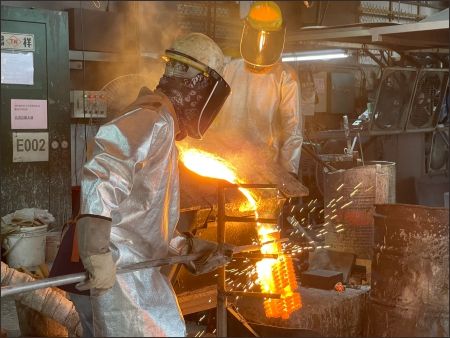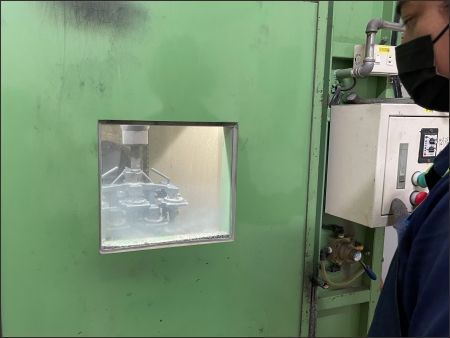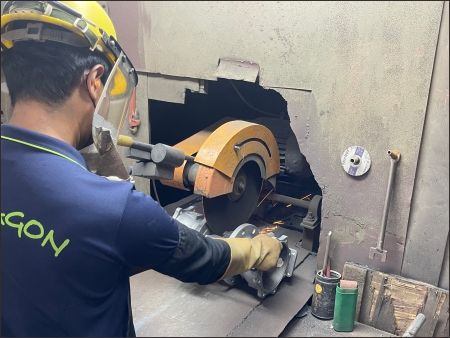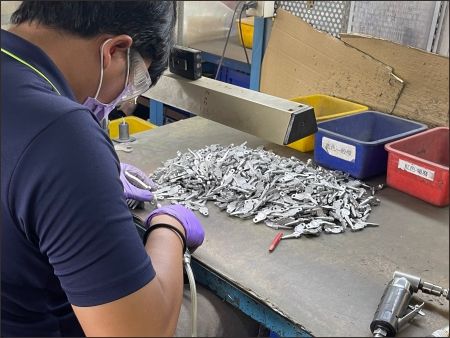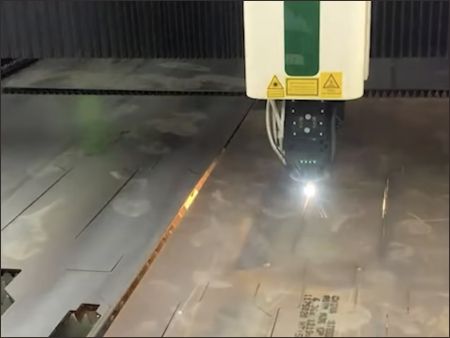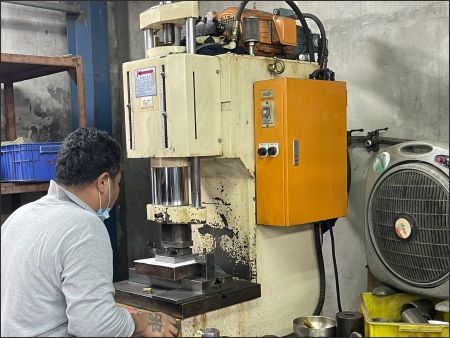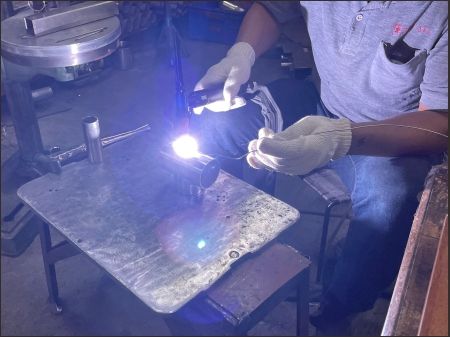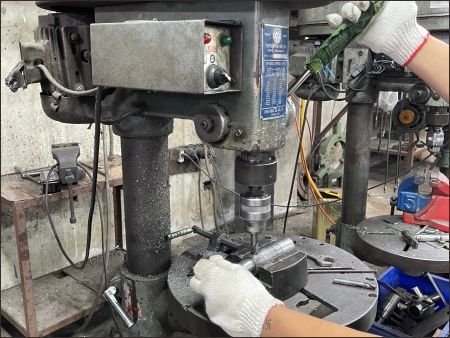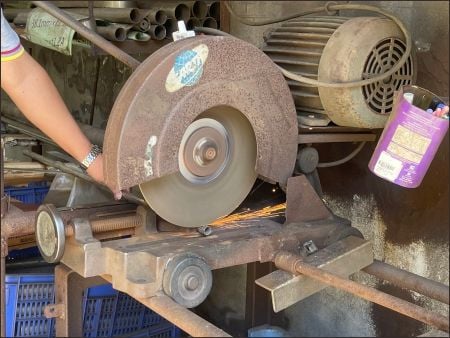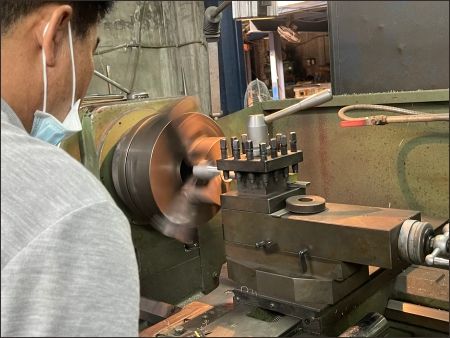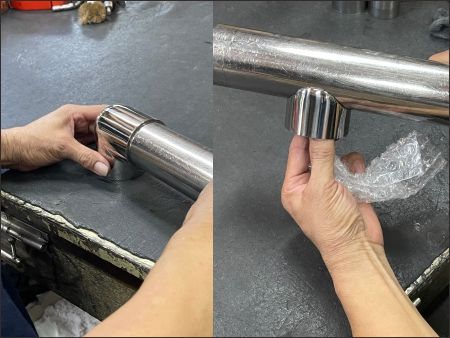
Manufacturing Process
Stainless Steel Components and Fittings Manufacturing - At First: Design & Making Molds
At Dah Shi, our team is committed to close collaboration with our customers throughout the design phase to final qualification. This ensures that both the die and the end products meet all customer requirements. Our handrail accessory designers work alongside die makers, utilizing the latest industry-standard software for design and fabrication. Our Computer-Aided Manufacturing (CAM) system efficiently reads data files and generates intricate molds, facilitating the creation of precise and cost-effective injection molds. Our engineers assess the castability of handrail fitting designs, and they offer recommendations to enhance casting performance and design. These engineers are well-versed in production processes and provide continuous support during manufacturing. No matter the source drawing, our engineers can transform it into a tangible solid model. This solid drawing grants you a clear visualization of the final profile of stainless steel railing accessories.
Stamping Process - Stamping Processing and Manufacturing of Stainless Steel Round Tube and Square Tube Fittings
Our design and manufacturing team has decades of experience in the stainless steel professional processing industry. We address customer needs for product thickness while considering post-installation safety and strength. We offer solutions using our stainless steel expertise, including round tube bases, stair railing accessories, stainless steel balls, handrail support with post joints, elbows, glass clamps, and square pipe fittings. We employ stamping, dewaxing casting, and laser cutting for production, focusing on construction details, customer specifications, safety standards, and installation efficiency to determine the suitability of punch stamping for round and square tube fittings. Our experts in the manufacturing of stainless steel stair railing accessories, emphasizing precision in design and production processes, ensuring our customers receive quality products that meet safety standards and can be installed quickly. Whether it's stair railing accessories or other architectural hardware, our stainless steel expertise has what you need.
Dewaxing process - stainless steel stair elbow dewaxing processing and manufacturing
At Stainless Steel Professional Processing, we specialize in lost-wax casting processing and produce a variety of stainless steel products, including tube bases and flanges, stair railing accessories, stainless steel balls, handrail supports with post joiners, stainless steel elbows, stainless steel clips, square pipe fittings, and various construction hardware.
Whether we are designing new stainless steel stair railing accessories or adopting a customer-supplied design, our commitment to quality and precision remains true. When designing new products or implementing customized designs, our engineers, with many years of manufacturing experience, consider the required functionality, safety, strength, and specific material composition of the product and consider the thickness loss required to achieve the desired product appearance. We use a dewaxing casting process to bring these designs to life, allowing us to open molds for production, ensuring every detail is accurately captured.
Once the stainless steel blank is sampled, we have detailed discussions with the customer on the basis of quality and accuracy to address subsequent steps in the manufacturing process. To ensure that high-quality stainless steel products can be provided according to customer-specific requirements.
Injection of Melted Wax for Pattern Making - The first step of the Dewaxing Process
Stainless steel processing technology involves several steps, and the first one in lost-wax casting is to create a wax model of the casting by injecting wax through a metal mold. This process begins by melting the wax material and then introducing it into the mold. Currently, two wax injection methods are available: fully automatic wax injection by robotic arms and manual wax injection. We carefully create an exclusive wax model for each required finished part to ensure that it meets the standards that match the drawings ordered by the customer. If customers only require a sample model, we also offer the option of 3D printing. This lets us quickly create the model and provide customers with the needed samples. Our specialized processing services offer flexibility to customers in developing new stainless steel elbows and architectural hardware, making it easy for them to achieve their design and manufacturing goals.
Repairing Wax Patter - The second of the Dewaxing Process
In the lost-wax casting process, once the injection molding of the stainless steel wax mold is finished, we carry out a meticulous manual inspection and repair of the wax mold. This is done to ensure that the rough objects that are subsequently cast don't have excessive burrs, thereby reducing the amount of time and effort required for burr removal. The wax model repair work serves as a cost-effective solution for our customers, as it saves them both processing time and costs.
Wax Pattern Tree Assembly - The third step of the Dewaxing Process
Before the casting process begins, we use precision molds to create a wax pattern of the stainless steel object. These wax patterns are connected to a central wax rod (called a "tree" or "sprue") through a "sprue", ultimately forming a casting cluster or assembly, which is then mounted on a pouring cup. We consider the ease of product processing when selecting gate locations to ensure no damage to the product body and to make grinding easier.
Dipping and Drying - The fourth step of the Dewaxing Process
In the lost-wax casting process, these tree-like components are soaked in liquid ceramic slurry and then covered with very fine sand to construct the ceramic shell. It is then left to dry in a dry environment, and the process of soaking and drying is repeated until the desired solid thickness is achieved, creating a ceramic shell mold for casting.
Dewaxing and Shell Building the Ceramic Shell - The fifth step of the Dewaxing Process
In the process of casting stainless steel, once the ceramic shell mold is established, the next step is to heat it. The purpose of this heating process is to completely melt the wax mold component of the tree-shaped stainless steel fitting, creating a hollow model ready to be filled with molten stainless steel metal liquid for the subsequent process. After being fired at high temperatures, the prepared hollow ceramic shell mold will quickly accept the injection of liquid stainless steel metal.
Melting and Pouring - The sixth step of the Dewaxing Process
Before pouring liquid stainless steel metal, the hollow ceramic shell mold must be fired at high temperatures to remove residual wax and moisture, further improve the strength of the ceramic shell mold, and enhance the fluidity of the molten metal alloy. Subsequently, the prepared liquid metal alloy with stainless steel components is poured into the preheated ceramic shell mold. After waiting for the stainless steel metal to solidify, the slurry ceramic shell mold is detached, and each stainless steel blank object connected to the tree shape is released.
Knockout and Cleaning - The seventh step of the Dewaxing Process
After the stainless steel lost-wax casting is completed, you must wait for the stainless steel liquid metal and ceramic shell mold to completely cool and solidify. We then use equipment such as a shell vibrating machine or physical treatments such as water spraying to remove the ceramic shell film. When the shell mold is successfully removed, only the individual stainless steel blank objects connected to the tree are left.
Cutting - The eighth step of the Dewaxing Process
After the stainless steel lost wax casting, the ceramic shell mold was shattered, and then we needed to remove the stainless steel blank object connected to the tree shape. Next, we must proceed to the next step: use a high-speed cutting machine to cut the tree-shaped stainless steel empty objects individually to separate them from the tree in the center. These cut metal blanks have an unprocessed dark gray metallic appearance.
Gate Removal - The ninth step of the Dewaxing Process
After cutting at the connection between the stainless steel blank object and the tree-like structure, so-called gate marks will be left. The work at this stage is to grind off the gate, but it must be done carefully to ensure that the stainless steel blank object body is not damaged and the stainless steel empty object body is not damaged. This will help the subsequent processing process, and the blank will not be damaged as for being scrapped and recycled.
Laser Process - Laser Cutting of Stainless Steel Plates
Our mass production method is mainly stainless steel lost-wax casting and stamping manufacturing, which is used to produce round tube bases, stair railing accessories, stainless steel balls, stainless steel handles and column joints, stainless steel elbows, stainless steel glass clamps, stainless steel square tube accessories for construction Hardware and other products. In the field of professional stainless steel processing, when the customer's design drawings require products with diverse sizes and small quantities, it is not cost-effective to produce stamping molds or dewaxed molds. To solve this problem, our draftsmen and manufacturing engineers will discuss disassembling the drawings and propose practical methods. We disassemble the product, draw precise manufacturing drawings, and then use laser cutting technology to process stainless steel plates or pipe fittings. This exact laser-cutting production method can not only save customers the cost and time of mold opening but also relatively improve the precision of product dimensions. We are committed to providing our customers with the highest quality stainless steel products; no matter what kind of product you need, no matter your quantity, we can meet your needs.
Inspection
Intial Inspection
After the stainless steel lost-wax casting is completed, we are committed to ensuring that the quality and size of the blank meet the highest standards, which includes measurement of the blank size and inspection of appearance. In terms of dimensional measurement, we will carefully check the parts required for subsequent processing, including thickness, hole diameter, and height, to ensure enough material for subsequent processing. If the size does not meet the standard and cannot be reshaped, we will immediately eliminate it and reprocess it. We will never sell substandard products to customers because we pursue customers' absolute confidence in our products and are committed to providing customers with 100% reliable products.
Material Analysis for Stainless Steel Components and Fittings
The stainless steel accessories we produce must comply with the international material standards for stainless steel metal proportions to ensure excellent performance and durability. Following each furnace casting, a test block is meticulously preserved, and a comprehensive material test analysis report is generated to verify compliance with industry standards. The material analysis composition table is available upon request for our customers' reference. At DAHSHI, we uphold the highest quality standards, providing you with reliable solutions for your stainless steel components and fitting needs.
Straightening
After the size measurement and quality inspection of the stainless steel blank, we will proceed with the shaping process of the blank. The purpose of this shaping process is to improve the dimensional accuracy of subsequent processing while reducing tolerances. For example, lathe processing after shaping is to increase the true roundness and reduce eccentricity to ensure that the accuracy of product dimensions is improved. Customers will not experience center deviation when installing or inserting round pipes.
Subsequent Processing
Welding
After the stainless steel plates are stamped or laser cut, we need to precision weld and combine these stamped or laser semi-finished products with other pipes and stainless steel blanks, then enter the polishing process. The welding process must ensure the solidity and integrity of the product after assembly to meet customer requirements for product functionality.
Drilling Tapping
Before drilling and tapping stainless steel blanks, we must perform shaping operations to ensure that the hole diameter and bottom surface are at the correct angle with the design drawing or are 90 degrees vertical. Only in this case can the threads of the screw holes remain vertical, and the center of the round hole will be in the correct position. We pay attention to the details of every manufacturing process to ensure that the final product meets high-quality standards and is perfectly functional.
Cutting Tube
In our product portfolio for producing stainless steel railings and handrails, we use round or square tubes of various sizes and lengths. To achieve this variety, we need to cut a large number of stainless steel pipe fittings during the manufacturing process. For products where round tubes are cut and require drilling, we use laser cutting technology, which allows us to achieve precise cutting and drilling efficiently. For those products with shorter dimensions and smaller quantities, we use high-speed cutting machines. We are committed to using appropriate processing methods to produce high-quality stainless steel handrail products for our customers.
Lathing
Before manufacturing stainless steel stair railing accessories, we first perform a shaping process to improve the roundness and flatness of the product. Through this step, we can ensure that there will be no center deviation during lathe processing. In this way, the product can achieve a perfect combination when installed and used. For high-volume but low-variety products, we use CNC lathes, and for smaller quantities but high-variety products, we turn to semi-automated lathes. We constantly pursue the best processing methods to ensure high-quality products.
Polishing
In the production process of stainless steel construction hardware accessories, polishing processing occupies a significant position. We must polish the burrs formed after drilling and tapping. Similarly, after the welding combination is completed, the welding position must be polished, and the parts processed by the lathe must also be polished. Our polishing process not only includes one process but requires 3 to 4 different processing stages to finally achieve a perfect surface treatment, including sand surface and bright surface treatment. Such fine processing ensures that our products meet customers' high-quality requirements in appearance and texture.
Final Inspection and Packing
At the final stage of the entire stainless steel fittings production process, we perform quality inspection and packaging operations. This quality inspection stage uses round tubes verified annually by a notary inspection unit, and each product produced is inspected individually. Only if it passes the inspection, meets the pipe diameter requirements, and has no defects, such as surface sand holes, etc., will it be packaged and shipped. We are committed to ensuring that every product our customers receive is high-quality and meets the highest standards.
Please contact us if you are interested in collaborating with Dah Shi for your professional manufacturing needs of stainless steel handrails, metal railings, and related accessories.

